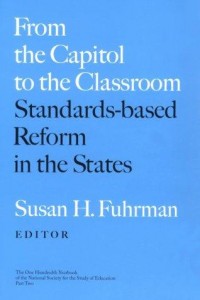Columbia University educational historian Susan Fuhrman discusses the constituting societal factors that spawned the standards movement.

When this reform notion emerged in the late 1980s, educators and policymakers were still experiencing the despair about lagging American achievement that drove the publication and response to A Nation at Risk. After the 1983 appearance of that Department of Education task force report, which charged that schools were characterized by “a rising tide of mediocrity,” policymakers at the state and local level responded by raising standards for both students and teachers. They increased high school graduation requirements, greatly added to the amount of student testing, and, in many places, made high school graduation contingent on passage of a competency exam. Teacher certification requirements were tightened, as were regulations about teacher education. The “Excellence Movement,” the term used to describe such belt-tightening efforts, was criticized by many educators as “top-down,” too directive, and constraining to schools. By mid-decade a reaction occurred, taking the form of efforts to devolve more authority to schools and create school based decision making bodies. “Bottom-up” reformers also promoted school restructuring, rearrangements of school schedules to promote teacher collaboration, sustained teacher-student interaction, and in-depth subject matter blocks. …
One reason for the appeal of standards-based reform was that our international competitors (those who scored higher than we did on the First and Second International Mathematics and Science Studies and other international assessments, those whose economies outperformed ours in the 1980s) used similar approaches. They had policy level (usually national) curricula, students and parents knew what was supposed to be learned, student assessment covered the stated curriculum, and teachers were prepared to teach that curriculum. This coherence of effort and consensus around school content appeared to be at least one factor giving other nations a leg up. …
A second reason for the attraction of standards reforms was the existence of seemingly successful American antecedents that could serve as models. The Advanced Placement (AP) program was a popular, well-known analog, which also carried a certain cache because of its college level course content. In that program, the curriculum, the examination, and teacher professional development were closely aligned. …
Third, research was showing that greater academic coursetaking, a result of the Excellence reforms, did not necessarily lead to greater learning because reliance on a single policy lever—course requirements—did nothing to assure that the content of the courses was improved or that teachers were well prepared to teach that specific content. … It seemed that more course requirements alone would not be sufficient, but that a much more comprehensive and coherent approach, using multiple policy levers of course requirements, curricula, teacher training, and assessment would be needed to improve student learning. This was a central part of the theory of standards-based reform: uniting previously diverse key instructional guidance mechanisms around common instructional goals.
Fourth, standards-based reforms seemed to be one way to reconcile, or to unite, the Excellence and Restructuring movements. Standard-setting, specifying the content and skills students should know and be able to do, might be an appropriate central role for districts and states. They could set high goals and monitor achievement on those goals, in keeping with the spirit of the Excellence reforms. …
Finally, the standards reforms offered the hope of more equitable instructional opportunities for all children. It was envisioned that standards would embody content and performance expectations for all children, and that by tying assessment to the standards, states and districts could monitor whether all schools were striving to achieve them. No longer would groups of students be written off and offered less challenging curricula; instead, all students would be offered more ambitious curricula pegged to standards. No longer would student assessment tap only low level skills and therefore have salience only for lower-performing students; instead, assessments would be aligned to challenging standards and cause all students to strive to learn the same content. The concept that challenging standards for all students would lead to better instructional experiences for all students was another central component of the theory of action underlying standards reforms.
Fuhrman, Susan. 2001. From the Capitol to the Classroom: Standards-Based Reform in the States. Chicago: National Society for the Study of Education. pp. 1-5. || Amazon || WorldCat
